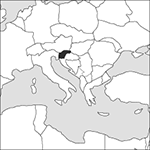
Source: MAPS IN MINUTES™ © RH Publications (1997)
Capital:
Ljubljana
Area:
20,273 sq km (7827 sq miles)
Population:
1,992,690 (2005)
Currency:
1 euro = 100 cents
Religions:
Roman Catholic 57.8%; Muslim 2.4%; Eastern Orthodox 2.3%
Ethnic Groups:
Slovene 83.1%; Serb 2.0%; Croat 1.8%
Languages:
Slovenian (official); Italian, Hungarian (official in some areas); Serbo-Croat
International Organizations:
UN; OSCE; EU; NATO; Council of Europe; WTO; OECD
A small country in south-east Europe.
Physical
Slovenia is bordered by Austria to the north, Hungary to the east, Italy to the west, and Croatia to the south and east. It has an outlet to the Adriatic Sea. The country is largely mountainous and wooded, with fertile valleys; there are extensive mineral and coal reserves.
Economy
Slovenia only had about one-tenth of Yugoslavia’s population, but was responsible for around 20 per cent of the output. The years immediately following independence were difficult as Slovenia lost markets in the other republics, but the economy soon revived as exporters found new buyers in the West. Industries include car manufacturing, iron and steel, aluminium products, lead and zinc smelting, electronics, and pharmaceuticals. Slovenia also has deposits of coal and mercury. Principal agricultural crops include potatoes, hops, cereals, sugar beet, and grapes. The main exports are vehicles (8% of all exports come from one Renault-owned factory), electrical equipment, chemicals, pharmaceuticals, and food.
History
The Slovenes are a west Slavonic people, ruled by the Habsburgs from the 14th century until 1918. After World War I the majority of the Slovene people were incorporated into the new kingdom of Serbs, Croats, and Slovenes, later Yugoslavia. In 1941 their lands were divided between Italy, Hungary, and the Third Reich. In 1945, 1947, and 1954, areas of the Istrian peninsula, including parts of the Free Territory of Trieste, were incorporated into the Republic of Slovenia within the Federal Republic of Yugoslavia. The most economically and educationally advanced of the Slav republics, Slovenes are predominantly Roman Catholic, with a strong Western heritage. During 1989 pressure began to mount for independence, and a coalition of six parties, the Democratic Opposition of Slovenia (DEMOS) emerged. In May 1990 it formed a non-communist government under President Milan Kučan, and in July declared independence, confirmed by a referendum in December. There was intermittent fighting between Slovene partisans and units of the Yugoslav army during 1990, before Serbia tacitly accepted the situation. In April 1992 DEMOS split, and the Liberal Democrats under Janez Drnovsek formed a government. A series of Liberal Democrat-led coalitions ruled Slovenia until 2004, with a brief conservative interlude in 2000. After 2004 centre-right and centre-left coalitions alternated in power. In 2004 Slovenia joined NATO and the European Union and in 2007 it adopted the euro as its currency. Unpopular austerity measures introduced by a centre-right coalition led to popular protests in 2012, while in 2013, economic reforms were hastily introduced to avoid an EU bailout for its banks. Elections in 2014 were won by the new centre-left Miro Cerar Party, founded just before the election by Miro Cerar, a law professor. Its victory was an indication of the electors' dissatisfaction with the political establishment. Cerar continued the process of stabilizing Slovenia’s economy.
- Bézier surface
- Bézout’s lemma
- Bézout’s theorem
- Böserup model
- Bølling
- Bølling-Allerød interstadial
- Bülow, Bernard, Prince von (1849–1920)
- Bürgi–Dunitz angle
- B–Z reaction
- C
- C#
- C*
- C++
- c
- C0
- C1
- C2
- C3 and C4 plants
- C3 pathway
- C4 pathway
- CA
- cabal
- Cabana, Robert Donald (1949– )
- Cabanis, Pierre-Jean-Georges (1758–1808)
- cabbage tree